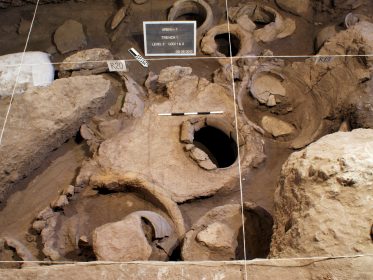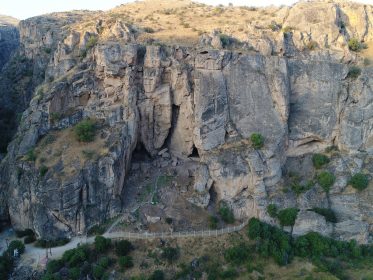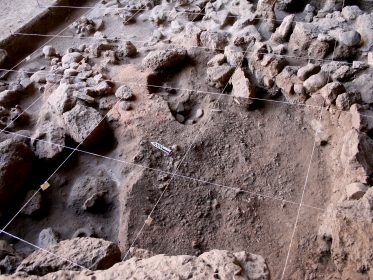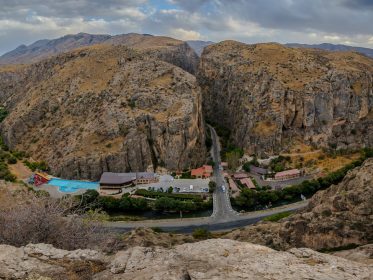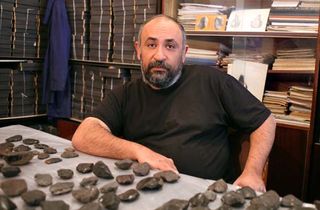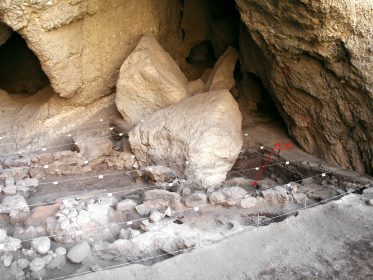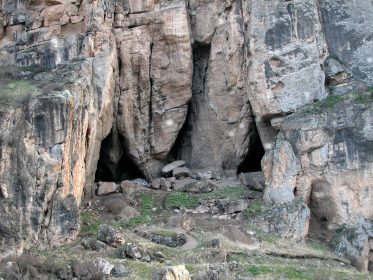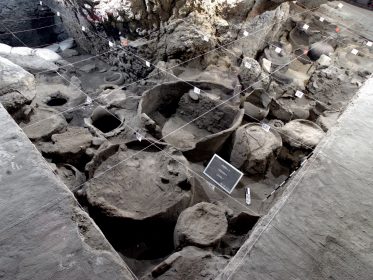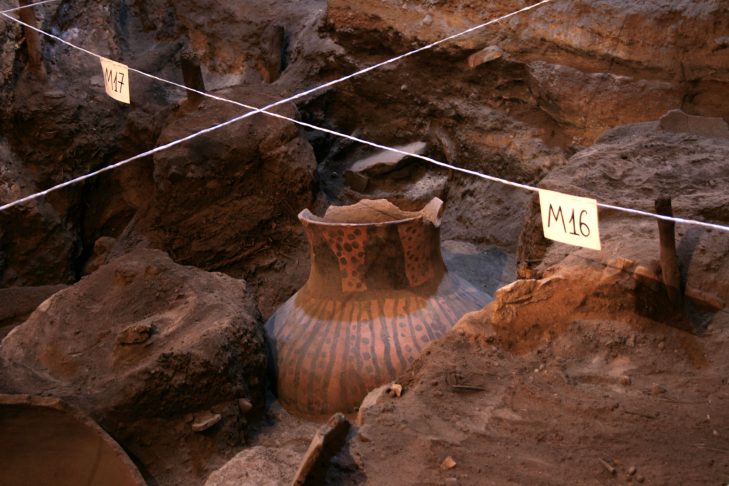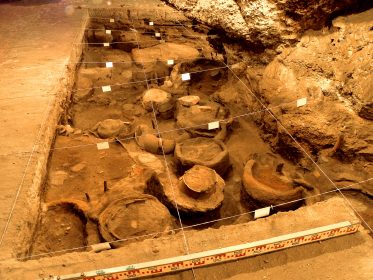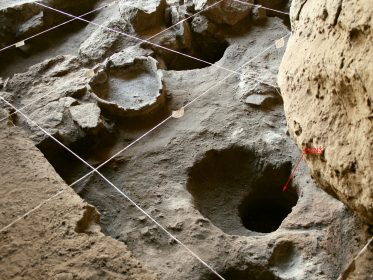Boris Gasparyan: “Our final goal is to create an archaeological park”
The legendary land of Armenia is hiding numerous mysteries and secrets. Primitive people settled among its valleys and mountains, which means that every pebble here can tell its own story. And archaeologists, who make their discoveries almost each year, help us understand such stories. Thus, in 2007, excavation began in a cave near the village of Areni, the history of which dates back to 4000 BC. Many artifacts were found there, including a 6,000-year-old winery! Thus, it is not by chance that this Armenian attraction became a Wine Travel Awards’ nominee and the voting winner of The Visiting Card of the Country nomination in the Authentic Location category. To learn more about this unique location, we talked to the head of the expedition, Department Member of the National Academy of Sciences of Armenia, Institute of Archaeology and Ethnography, Boris Gasparyan.
There are probably many caves in the mountainous area of Armenia. Tell us about this region. Why were archaeologists interested in this particular cave? What does the name “Cave of Birds” come from? And what does the figure “1” in the name of Areni – 1 mean? How many caves of such a kind can be discovered in these places?
The landscape of Armenia is very rich with caves and rock shelters, which are spread all around the country. They have different origins, size and morphology. Karsts are the most interesting among them, like Areni-1 cave, which is formed in in sedimentary marine limestone rock-formations on the left bank of the Arpa River, near the point of its confluence with the tributary Gnishik and at an elevation of 1070 m above the sea level.
Comparing with neighboring Georgia, in Armenia karstic caves were not excavated, this is why our study was focused on test excavating such caves in the northern and southern parts of the country, where they exist. Areni-1 was selected as a cave with interesting location, its size and because of being a dead “karst”, i.e. ground water activities were finished here thousands of years ago and it was dry inside of the cave. Local people call it “Bird’s Cave” or “Cave of Birds”, because nests of cave swallows and other birds are visible closer to the roofing of the cave. It is also home for 14 types of bats, organizing their lifeways inside of the cave.
Figure “1” in the name of the caves is given based on the legislation of recording archaeological sites in Armenia. “Areni” reflects the community, “1” reflects the number of the archaeological site. So “Areni-1 cave” is how the site is recorded in the official list of the immovable monuments in Vayots Dzor Province, meanwhile “Bird’s cave” is also in use, for keeping the local toponim. There are also Areni-2, Areni-3, Areni-4 etc. caves which are spread in the same area and some of them keep traces of activities, which are similar to the ones characteristic to the Late Chalcolithic inhabitants recorded in Areni-1.
What initiated the archaeological expedition in Areni, which institutions and from which countries participated and what were their functions and goals? Were those the representatives of specialized wine organizations? And how long did it take to prepare the necessary documents and permits – as we are aware, for example, from the experience of vineyards in the archaeological complex of Pompeii, it can take decades.
The archaeological expedition in Areni was initiated for two reasons. It was an archaeologically poorly studied region as well as our goal was to record traces of early hominin activities in the Arpa River valley. The goals were achieved, meanwhile we discovered the wonderful world of Late Chalcolithic people who exploited this unique ecological niche in very specific ways and which was new for us. Previously it was thought that caves “attracted” people of Paleolithic period and their role in organization of lifeways decreased with the rise of Early Agricultural societies and onwards. Excavations of Areni and numerous other sites in Armenia showed that this is not true. Caves continue to be important cultural spaces even in the Late Medieval period, where different types of human activities (hiding or secret shelters, hunting camps, religious and ritual performances) continued to take place.
The excavations in Areni-1 started at 2007 as a joint Armenian-Irish archaeological project (The Institute of Archaeology and Ethnography of the National Academy of Sciences of the Republic of Armenia and the School of Archaeology, University College Cork, Ireland), with an aim to study the initial occupation phases of the Arpa River valley. In 2008 Cotsen Institute of Archaeology at UCLA (USA), joined the project. Main sponsor of the Areni-1 cave excavations is the Gfoeller Renaissance Foundation (USA). Among the other important sponsors were the Institute of Archaeology and Ethnography of the National Academy of Sciences of the Republic of Armenia, the National Geographic Society, the Steinmetz Family Foundation, the Chitjian Foundation, and the Boochever Foundation. Funds for the site’s preservation (fence, electricity, passages, warehouse) and for the information panels were provided by the U.S. Ambassador’s Fund for Cultural Preservation.
All three parties and team members from them were cultural and physical anthropologists. There were no wine specialists and/or archaeologists who were specialized in archaeology or history of wine. They later joined the project. The permits were obtained very quickly as 1/3 of the site was heavily destroyed and covered by concrete, and the excavations conducted here were kind of safeguard excavations for stopping the destruction of the site in the future.
What was the first artifact you found that impressed you the most?
First artifacts that impressed me the most were reed straws discovered in one of the karases or the earthenware pots that belong to the wine production installation. I said to myself: “God, this has to be related to winemaking, because it reminds me of Xenophon, 5th century Greek historian describing the Armenian wine cellar”. He wrote in his “Anabasis” the following: “There was also wheat, barley, beans, and barleywine in big bowls. The very grains of the barley were in it, floating level with the brim, and there were reeds lying in it, some of which were longer, others shorter, but without joints. When one was thirsty, he had to take one of these to his mouth and suck. It was quite unmixed (and strong), unless one poured in a bit of water, and the drink was quite pleasant for one who had learned to be familiar with it. (Xenophon 2008:138, Book IV, Chapter V)”.
Boris, the fact you rented this cave created an interesting precedent. Please elaborate on conditions and for what period you managed to do that.
The government of Armenia decided to give to some private organizations several cave sites for rent, which could be exploited as a touristic destination and generate some income for the future preservation of such kinds of sites. Areni was the most “suitable” as some steps were always undertaken before the above mentioned project started. The goal of our project which was then accepted by the Government of Armenia was to bring together the three following tasks – the scientific study of the site (excavations, reconstructions, etc.), preservation of the site and the elements uncovered during the excavations as well as turning the site into an interesting touristic destination for the visitors which will not contradict with first two goals. Our consortium (“Areni-1 Cave” Scientific-Research Foundation, Armenia and the “Gfoeller Renaissance Foundation”, USA) was able to undertake the project and rent the cave for 25 years. We deeply believe that excavations, preservation and conservation activities of the site in parallel with organizing attractions for tourists is the best way to preserve the heritage. Meanwhile, our funds secured from the tourism are oriented to excavate, study and preserve other sites located in the vicinity (Areni-2 Cave, Gnishikadzor Archaeological Complex, Gnishikadzor-1 rockshelter, Yelpin rock-cut complex, etc.), and which are related to the history of the inhabitants of Areni-1 Cave. Our final goal is to create an archaeological park and tie together a net of sites and destination, where our tourists and visitors can spend two-three unforgettable days and learn information on history of viticulture, winemaking, the origins of ancient crafts, the rituals and worldviews of ancient people living in Arpa River Valley millennia.
What can you tell us about the life of the people who lived there thousands of years ago? This cave was used as a home, a utility room, a place of worship or all together (as far as we know, there were burial sites in the cave – why were the skulls kept separately? What kind of memorial plaques were installed – what was written on them, in what language)?
Humans started to use the cave in the Lower Paleolithic, around 2-1,5 million years ago, which probably served Homo erectus as a hunting camp or seasonal shelter. Also Neolithic people in late 7th Millennium BC used the rare part of the first gallery for habitation. The most long exploitation of this ecological niche (the Areni-1 cave) was recorded during the Chalcolithic period (5300/5200 Cal BC – 3400/3300 Cal BC), especially during the Late Chalcolithic (4400/4300 Cal BC – 3400/3300 Cal BC). During this period (around 1 thousand years) the inner part of the first gallery of the cave was used as a “temple” where very complex seasonal ritual activities were taking place, probably in autumn, related to the dying and reviving god, fertility and the natural cycles. Also the part at the entrance of the same gallery was used for habitation and organization of production of goods (metal artifacts, leather implements and clothing, mats and basketry, bone tools etc.), which means that this space was occupied by craftsman, who were guarding the “temple” and in parallel were making goods for the upcoming rituals took place inside of the cave.
Very limited Middle Bronze and Early Iron Age (2200/2100 – 900/800 Cal BC) occupation traces were recorded in different parts of the cave. Next intensive occupation is recorded during the whole Medieval period (4th – 18th centuries AD), when the cave continues to serve as a habitation area, space for economic activities and trade point near the Silk road, secret place for hiding manuscripts and goods and finally short term shelter for refugees after the Russian-Persian, Russian-Turkish wars and the 1915 Genocide, who migrated to the region and start finding villages for further organization of their life.
There is only a single baby or infant burial inside of the cave from Late Chalcolithic Period. The rest of the clay structures are just ritual beans containing some goods (basketry, metal and stone artifacts, seeds and other plant remains) in addition to some human body fragments – skulls without lower jaws, femurs, ribs etc., which bear traces of cut-marks, polishing, fire and traces of being chewed by humans. That means that people were sacrificed inside of the cave during the complex rituals which also were related to the cult of the human body.
Memorial plaques installed at the site are telling general information about the cave and its excavation history. Also each trench (there are six) has a separate plaque explaining the stratigraphy and the meaning of finds discovered in a specific trench. The texts are in three languages: Armenian, English and Russian.
In 2011, archaeologists discovered the world’s oldest – a 6,000-year-old – winery in Areni Cave. Undoubtedly, we are very interested in the history related to wine. Tell us, please, what signs led you to believe that there was a winery in the cave? What specific tools and dishes were found in the cave to confirm this fact?
The wine making complex or the wine production installation was discovered in 2010, in the rare part of the first gallery together with the ritual bins (they belong to the Late Chalcolithic Horizon II). First idea that this construction is related to winemaking came with the discovery of reed straws inside of one of the earthenware pots for aging the wine, as it was mentioned above. Also the details of the structure and the construction concept (platform with a noticeable angle wrapping the installation tank, series of earthenware pots or karases in Armenian for storing and aging wine), which are the same as the ethnographic period wine making installations in the Armenian houses, in addition to the archaeobotanical finds (remains of pressed and crushed grape skins, seeds, branches, pedicles etc.) on the crushing platform and inside of karases, as well as the results of the archaeo chemical analyses are out of reasonable doubt, that in Areni-1 we have recorded and ancient wine making complex. Some artifacts related to wine consumption are also talking about this. They are presented by drinking straws and especially a cup made from a combination of horn and wood, which is for drinking wine. It is the cup of revival, probably the prototype of the Holy Grail.
Does this discovery allow us to say that Armenia can claim the status of the cradle of winemaking, just like Georgia? Is it a winery that nevertheless existed during a later period, and two centuries separate the artifacts used as the evidence of this fact?
Neither Armenia, nor Georgia are able to claim a status of being the cradles of winemaking, even based on the existing wonderful discoveries. Both countries which boundaries were established around 30 years ago can’t be a cradle of anything. It is more scientifically correct to talk about the region (Asia Minor, Armenian Highlands, Caucasus, Iranian Plateau) to be one of the ancient cradles of winemaking together with the East Mediterranean, Levant, Europe and the southern parts of the Russian Plain. The archaeology of viticulture and winemaking is a very young branch in archeological study and I am sure many new and interesting discoveries regarding the ancient cradles of winemaking are waiting for us. In any case, in the face of Areni-1 we have the first known wine production facility which is also claiming the initial steps of the wine domestication. Initial stages of wine production are strongly related with the rituals which took place in the cave and the first steps of winemaking belong to the ritual world of our ancestors. It appears only since the Iron Age (1st Millennium BC) that wine making has become an important branch of the economy and getting to everyday life, but still requiring a series of important rituals regarding its production, transportation, storage and consumption.
Was chemical analysis carried out in order to establish which beverages had been stored in the clay vessels? Is there any information about what kind of wine it was: sweet or dry, strong, red or white?
Chemical or archaeo chemical analyses are not able to tell which beverages had been stored in the clay vessels. Archaeological excavations in the Areni-1 cave revealed installation and artifacts dating to around 4000 Cal BC that are strongly indicative of wine production. Chemical evidence for this hypothesis is presented using a new method to detect the anthocyanin malvidin that gives grapes and pomegranates their red color. Using solid phase extraction (SPE) and alkaline treatment of the potsherd samples, followed by combined liquid chromatography-tandem mass spectrometry (LC-MS/MS), this method was applied to authentic standards. A positive result was observed for two of the samples from the Areni-1 cave, adding evidence supporting the hypothesis that wine was produced in the Armenian Highlands in the Late Chalcolithic Period, found inside one of the large storage jars, produced a positive curve with a small but clearly detectable amount of syringic acid in the 50% organic fraction. The second potsherd from inside the large storage jar in the Areni-1 cave complex also returned a positive curve. Vessels such as those found partly buried inside the central gallery of the Areni-1 cave appear well suited to receive grape juice, or a combination of grape juice and other ingredients (for instance hawthorn or pomegranate juice, or resins), and store it during its fermentation into wine. This obviously does not constitute irrefutable evidence, but chemical data pointing in the same direction can now be added to the archaeological argument.
An information source for the reconstruction of the first and initial wines can serve the results from the experimental archaeology. As of it is clear that in Areni-1 grapes are at the initial stages of domestication, not much different from wild grapes and wild grapes are still growing in the Gnishikadzor canyon, not far from the cave, as well as the limited amount of wine produced inside of the cave (judging from the karases or the earthenware posts this was around 150 liters), our consortium initiated an experimental project of preparation of wine from wild grapes with simple methods, which are visible from the study of the ancient wine-making installations. The result was a red, dry wine, containing around 10.3-10.5% of ethanol based on laboratory analyses.
Are there any artifacts related to the wine culture in those ancient times? Perhaps in the images on the walls of the cave or the chronicles? How popular was this drink in those days?
There are numerous artifacts related to the ancient wine culture discovered during the excavations of the cave as it was mentioned above. Those are drinking reed straws, cups and glasses from horn and clay, in addition to a metal bowl fragment, which can be also related to wine consumption. Such artifacts are also visible from the Medieval layers and contexts of the cave which are distributed with glass and clay drinking bowls, cups and other vessels characteristic for winemaking and wine consumption. Among them one of the most interesting is the iron pruning knife which is dated to the 13th-14th centuries AD. This kind of grape pruning knives are very well known from the illustrations of medieval Armenian manuscripts. In addition drinking straws, drinking vessels and cups are very well known from the images depicted on terracotta, bone, metal artifacts (reliefs, seals, decorated drinking bowls, etc.) known from the Chalcolithic and Bronze-Iron Age monuments of the Ancient Near East.
All these images are showing how important wine production and its consumption were for the Ancient societies as a whole. Two important drinks – wine and beer were at the center of the identity, worldview and philosophy as well as the rituals which guarantee the chains of life supporting cycles, eternity of the tree of life and later on the economy and provisioning of the administrative networks and trade. Wine was the symbol of revival and rebirth. It was deeply believed that wine is connecting two worlds together – the real world or the world on the Earth and the virtual world where the dead people and goods live. So it was believed that everyone drinks wine – alive, Gods and dead living in the next world.
Tell us about the last expedition together with Czech archaeologists. What new finds and discoveries were made in Areni-1 Cave?
We excavated with our colleagues from the Czech Republic not the Areni-1 cave, but some new sites in the vicinity. Meanwhile, our Czech colleagues helped us to create a 3D reconstruction of the cave and some important artifacts discovered there. Among the most intriguing and attractive work was the reconstruction of the faces of three skulls, which were recorded around the winemaking installation. Now we have three individuals looking at us from the monitor of the computer, the representatives of the Chalcolithic complex society which was creating the ancient wine and domesticating the grapes, learning the skills of irrigation, establishing metalwork and making shoes and beautiful mats, modeling the universe and putting the sun into its center, interpreting the nature with their own intellectual tools (water, dragon, sun energy and sun hero, thunder sword, etc.) based on repetitive observations of the natural cycles (for example the circulation of water in the nature).
Currently, the contemporary Armenian winemakers are restoring the world’s oldest winemaking culture. Are there any special tours to the cave organized for wine specialists? What information do you think might be of interest to wine connoisseurs and wine lovers?
The contemporary Armenian winemakers are trying to claim that they are reviving the ancient traditions of Armenian winemaking culture. And there is some truth in it, because much of ancient knowledge is being used in the industrial production of wine, related with traditional varieties of grapes, their production on a big scale, as well as stories told by their grandfathers and grandmothers. But there are still lots of things which need to be discovered, studied and explained. This is where our consortium is being very actively helpful, by means of study results on the history of ancient wines that we produce and innovate each year.
Each year we are organizing special tours for specialists who are interested in past viticultural landscapes, in the history of production of first and initial winemaking, ritual ceremonies related with wine, depending on individual and group requests. We think that different aspects of the origin of vine domestication, the meaning of different traditional operations existing in the Armenian viticulture, as well as the archaeological and historical phases which can be seen behind the archaeological study of winemaking in Armenia can be selected among the most interesting for the visitors. In addition the philosophical meaning of wine, its relation to the rituals of the past and religion in general are also not less interesting and attractive. And finally we are planning to organize wine tasting tours for people who really are lovers of wine to provide them with lectures about wine and ancient ways of wine drinking in parallel with a chance to test wine from wild grapes, after which they will see the cave as an archaeological site.
Every October, Armenian winemakers and tens of thousands of visitors gather at the Areni Wine Festival. Tell us, please, about this holiday.
The Areni Wine Festival appeared as a result of the discoveries made in Areni-1 cave by the archaeologists. The earliest leather shoe of Eurasia and the oldest wine making complex made the site world famous very quickly and the amount of local and foreign visitors to the cave started growing noticeably. I was personally in the organizing committee of the festival at its initial stages. The goals of the festival were to promote Armenian ancient viticulture and winemaking culture, to make visitors be closer to the place where ancient wine production of Armenia was recorded, to push the local community to touch their own history and to be part of it, as well as to create and event which will give a chance to sell local food and drinks and get some income. Each festival people visit our cave during the days it is running. The peak of visiting the cave during the year is related to the festival, where the chain of the visitors is endless from the morning until the sunset.
Are there any plans to turn Areni-1 Cave into a museum with modern attractions, operating winery, and ampelographic collection of vineyards?
Areni-1 cave as a touristic destination is in the initial stage of its development. Our vision for the widening of the touristic infrastructure of the site is to open a museum inside of the third gallery covered by concrete in the past, where people can see some of the most interesting finds discovered from the excavations. In addition we are planning to create a wine tasting hole as it was mentioned above, where people can take an experience of ancient ways of wine drinking and taste the wines from wild and wildgrowing grapes. Souvenir and gift shop is also in progress where we are planning to sell and spread some knowledge to the visitors represented by local fossils, minerals (the area is very rich with such), replicas of finds from the cave, also products created by local craftsman, books, posters, t-shirts and others things which are usual for each archaeological site in the world providing touristic service. Among our important plans is to create a 3D attraction using the animation techniques, where people can “talk” to the ancient winemakers living in the cave and use the facade reconstructions done with our Czech and Brazilian colleagues.
Among our goals is also to connect the visits to Areni-1 cave with Gnishikadzor Archaeological Complex, which is less than 5 minutes’ drive from the cave. The site is practically an ancient vineyard, which was excavated by our projects during the year and prepared for the visitors who can learn a lot about the history and methods of ancient viticulture. We are planning to revive the ancient gardens around the site and establish the functioning of old irrigation canals, supporting the growth and preservation of local grape varieties still visible in the area of these gardens. Growing wines which have around 50 cm of diameter of the trunk still exist in the area. In parallel, together with our Armenian and German colleagues we established the DNA study of the grapes, which is adding not less interesting information regarding the roots of vine domestication.
We deeply believe that after realization of the above mentioned scope of activities Areni-1 cave and the Gnishikadzor canyon will be presented not only as one of the important points of initial winemaking, but also one of the cradle points of vine cultivation and domestication.
We wish you strength and aspiration for the realization of this unique, globally significant project!
Author: Oleksandra Hryhorieva
